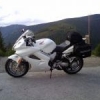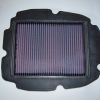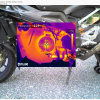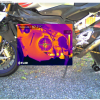-
Posts
543 -
Joined
-
Last visited
-
Days Won
2
Content Type
Forums
Profiles
Gallery
Blogs
Downloads
Events
Posts posted by coderighter
-
-
I've had the TC FPR for 2-3 years now.
Definately improves low-end throttle responce.
Before the change, mine (throttle responce) was so bad that I would dread geting into traffic. Now it's MUCH better. Not perfect, mind you, but MUCH better

No PCIII here, O2s unplugged, pair blocked.
I can't find the FPR on TC can you post a link, I have a 01 vfr800,Thank you
Turbo City stopped selling the FPR units. At present, I don't find anyone that makes/modifies an FPR for the VFR.
You can always order one for a Blackbird.
-
Actually, the stators don't generate amps, just voltage. The amperage is dependant on the load the stator 'sees'. If you're not shunting (loading) the stator to regulate voltage, the amps drawn should only be what's needed by the bikes electrical system, minus rectifier and 'normal' regulation losses.
-
My SH775 has been working for 22,000 miles with no problems but i really do not run my bike in the high r.p.m. range.
And the higher-output series-type has been "under development" for at least 2 1/2 years.
I'm just going on "wisdom from the Internet" (which, it must be remembered, used to recommend the CompuFire...), but there have been some reported failures of the SH775 at high rpms. Shindengen's website has this graph showing their series-type reg/recs:

I haven't ordered a box-full of Vstrom reg/recs yet, but I think it is possible that this is one the 50A series reg/recs shown as "under development" in the table above, and if so, could be the "OEM-type" solution we have been waiting for. More guinea pigs required!
Ciao,
Of coarse, V-strom is a twin so.....
-
http://www.roadstercycle.com/Roadstercycle%20Series%20Regulators.htm
Anyone know if this 50 amp unit can take the higher rpms? Or is it the same as the Compufire?
I've been running one for about 4k miles now, no problems. I've installed a meter to monitor. Shortly after to install, I ran it up to 12k a couple times (close to home), voltage never over 14.8.
-
whatcha got there?Frankin filter
Is that a stock filter frame with a BMC filter element? Inverted?
Sent from my SCH-I200 using Tapatalk
http://www.vfrdiscussion.com/forum/index.php/topic/65961-frankenfilterit-breathes/
-
-
For those interested in doing there own installs, I will continue to make the relays that prevent the ballasts from being energized until the bike starts. The relays also now include a "override" in case you want lights before the bike is running. You can also use the "override" to hold the ballast energized when the high beams are on. PM me for details.
-
My Compu-Fire died under high rpm.
http://www.vfrdiscussion.com/forum/index.php/topic/74088-my-compu-fire-regulator-died-today/
I replaced it with a Cycle Electrics 50 amp series R/R (I'm not giving up). First trip out I ran the RPM up (close to home), no problems. Couple thousand miles now, so far, so good.
http://www.vfrdiscussion.com/forum/index.php/topic/74126-ok-second-try-for-a-non-shunt-type-rr/
-
The issue I would have is that SH775 is only 35Amps....It has to be able to switch the potential load, not just the current (haha) load. I would prefer a 50Amp specced item.
What is the best source these days for an alternate Series RR? Compufire?
My Compufire died (I suspect over voltage on the input side). I'm using a Cycle Electrics, it's 50 amps and a true series style. I verified it's a series style by measuring the current from the stator to the R/R. I was going to use the 'load to heat' method, but I just happened to have a meter handy.
Details here -
http://www.vfrdiscussion.com/forum/index.php/topic/74126-ok-second-try-for-a-non-shunt-type-rr/
Harbor Fright sales a little load bank perfect for that. Dont remember the model # but it seems like it was $60-$70 ...
I just used an amp meter. Why would you need a load bank?
-
The issue I would have is that SH775 is only 35Amps....It has to be able to switch the potential load, not just the current (haha) load. I would prefer a 50Amp specced item.
What is the best source these days for an alternate Series RR? Compufire?
My Compufire died (I suspect over voltage on the input side). I'm using a Cycle Electrics, it's 50 amps and a true series style. I verified it's a series style by measuring the current from the stator to the R/R. I was going to use the 'load to heat' method, but I just happened to have a meter handy.
Details here -
http://www.vfrdiscussion.com/forum/index.php/topic/74126-ok-second-try-for-a-non-shunt-type-rr/
-
Now I will warn you if you have a Electrosport R\R it performs just like Shindengen SH775.
The same way Dennis Rodman performs like Michael Jordon!
Yeh except BETTER !!!!!!!!
And I think Dennis Rodman understand OHM'S LAW !!!!!!
That's properly not the only law Dennis doesn't understand.
-
Now I will warn you if you have a Electrosport R\R it performs just like Shindengen SH775.
The same way Dennis Rodman performs like Michael Jordon!
-
My oem shunt with over 100,000 miles doesnt run hot at all, I think there's more to it than many think or Blame.
2 words.
Weak magnets.
-
It's simple, if it doesn't say cubic zirconia, then it must be a diamond.
-
Which Shindengen is a Series unit? Most I have seen are Shunt or MOSFET (still shunt, just more efficient)
SH775
And unlike the Electrosport, it really is a series type. I guess Polaris is using them.
-
Electrosport doesn't make a series-type reg/rec. (Haven't we been through this before?)

I thought so...........
-
HID's them self have nothing to do with the failures. Any feedback that could possibly harm the stator or R/R, would toast the ECU first.
However, a shunt regulator basically needs to shunt 'unused' power to ground to control voltage. By changing your 55W bulbs (110 watt total) to 35w HID's (70 watt total), you're asking the R/R to 'consume' and extra 40 watts.
Whats interesting is that even thou that could be an 'issue' for a shunt R/R, it's a benefit for a series R/R, since that power doesn't have to be rectified and 'consumed'. With a series R/R, that 40 watts is never produced, reducing heat (and drag).
So, to summarize, have there been any actual series-type reg/rec failures as of yet?
Ciao,
I think just my Compufire this last March.
Yeh BUT i went to the series R\R type when I installed the HID's.
Which series R/R did you install?
-
HID's them self have nothing to do with the failures. Any feedback that could possibly harm the stator or R/R, would toast the ECU first.
However, a shunt regulator basically needs to shunt 'unused' power to ground to control voltage. By changing your 55W bulbs (110 watt total) to 35w HID's (70 watt total), you're asking the R/R to 'consume' and extra 40 watts.
Whats interesting is that even thou that could be an 'issue' for a shunt R/R, it's a benefit for a series R/R, since that power doesn't have to be rectified and 'consumed'. With a series R/R, that 40 watts is never produced, reducing heat (and drag).
So, to summarize, have there been any actual series-type reg/rec failures as of yet?
Ciao,
I think just my Compufire this last March.
-
Yeh and mine just failed with a series R\R and had one burnt spot at the very top of the stator and I figure our bike's run alot hotter then the bike in the FLIR photo.
I thought you were OEM R/R?
Mine has failed three times at around 40,000 miles the factory stator(replaced with Ricks) failed at about 51,000 miles the factory R\R opened replaced with Electrosport series R\R. At 64,000 the stator failed again, replaced with the Honda stator and Shin R\R.
I did a quick search and Electrosport doesn't appear to make a series design R/R. All I could find on their website were shunt style. If you search the word 'series' on their site several R/R's show up, but the word 'series' is denoting a group, not a regulator design. Kind of like a BMW 5 series, a group of cars based off the same platform.
If you used a true series type R/R, under normal use, the actual power produced by the stator would be cut by 25-35% ( more with HID's and LED's ) which should reduce stator heat by the about same amount.
That would make sense I have HID's but not for long ..
Thanks Coderighter .....
Just wondering, why are you removing the HID's?
-
Yeh and mine just failed with a series R\R and had one burnt spot at the very top of the stator and I figure our bike's run alot hotter then the bike in the FLIR photo.
I thought you were OEM R/R?
Mine has failed three times at around 40,000 miles the factory stator(replaced with Ricks) failed at about 51,000 miles the factory R\R opened replaced with Electrosport series R\R. At 64,000 the stator failed again, replaced with the Honda stator and Shin R\R.
I did a quick search and Electrosport doesn't appear to make a series design R/R. All I could find on their website were shunt style. If you search the word 'series' on their site several R/R's show up, but the word 'series' is denoting a group, not a regulator design. Kind of like a BMW 5 series, a group of cars based off the same platform.
If you used a true series type R/R, under normal use, the actual power produced by the stator would be cut by 25-35% ( more with HID's and LED's ) which should reduce stator heat by the about same amount.
-
Yeh and mine just failed with a series R\R and had one burnt spot at the very top of the stator and I figure our bike's run alot hotter then the bike in the FLIR photo.
I thought you were OEM R/R?
-
Let's look at the thermo's again.
Keep in mind the each image is scaled independently, with white being the hottest and black being the coldest you can't compare images color to color. The plus target in the middle is the is the target temp. I'll doing the conversion from Celsius to Fahrenheit.
The first image is scaled 78-302 and the targeted is temp 237. This is with the shunt R/R
The second image is scaled 71-345 with the target temp being 206. This is with the series R/R. The difference is 21 degrees but it's actually a bigger difference than that because the highest temp on the second image is higher, meaning the engine temp as a whole was likely higher. -
Can you see it in the daylight ? Can not see mine but it is LED.
PS not running I hope 12.7 little low.
HELLO HELLO anybody home ....
#13
-
They say it's 'Splash proof'. Mine came with a rubber gasket for the back, so I don't think that will be a problem. I only ride for fun, so I avoid the rain, but I guess if needed, I could clear coat the whole thing.
It's very easy to see during the day, but there's no back light for night. However, around town, street lights are enough to see it.
I have a female RCA jacket in place of one of the inner push clips that I have hooked to the battery which I use for charger or aux. I was in a hurry to take a ride, so for now I have the meter plugged into the RCA. In future I'll put it on the battery directly.






The Bigger Fuel Pressure Regulator Question.
in Modification Questions
Posted
When the bike is in closed loop, the map is safely on the rich side and the signal from the O2 leans it out for fuel mileage and emissions. It's done this way so if the O2 sensor, or sensor circuit, where to fail there is no melt down. By eliminating the O2 sensors you made the O2 signal voltage zero which makes the ECU think the bike is lean, making the bike run on the safe rich side. However because you had the Turbo City FPR, it was the 'extra' rich side. If you would have left the O2 sensor, closed loop would have dialed the extra fuel out at cruise and your fuel mileage would have been unchanged at cruise. You would have still had a very small decrease in fuel mileage outside of closed loop, but that would have been fairly slight. In theory, there is no throttle response at cruise so having closed loop leaning things back out should not be an issue, thou it might make for a surge coming off cruise.